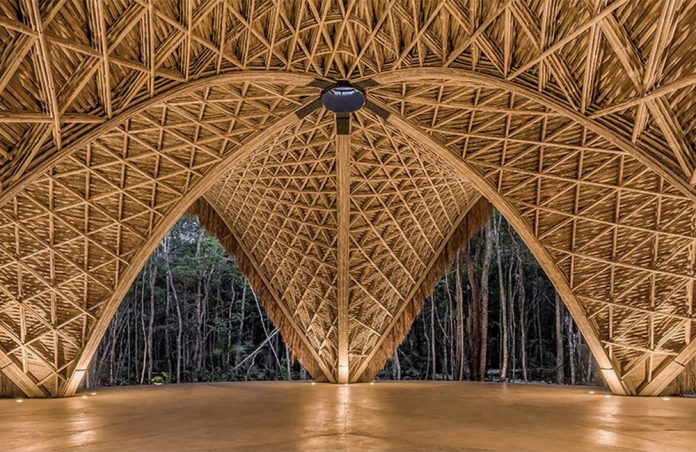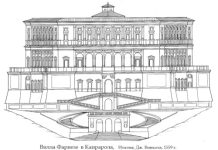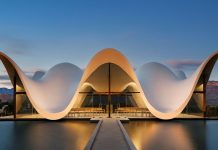The world is created – traditional philosophy teaches – and everything that is created by human hands is created like the world.
This idea, which has been embedded in the traditional consciousness since time immemorial, identifies all creative activity, including construction, with the act of creation of the world. The principle of similarity of the symmetrical correlation of practical reality and ideal reality determines the range of ideas about how the world should be created. A kind of “model” is known in advance, which the master must reproduce. He is not engaged in shaping as such, but creates a small world in the image and likeness of the big world.
The translation of figurative representations into the language of architectural graphics presupposes a means of composition adequate to the structure of the transmitted image. Such a means is the reception of symmetrical arrangements.
The knowledge that the world is centered, originated from a single point and has a single axis, essentially deprives builders of choice. The spatial axis is predefined. According to the idea of its similarity, it cannot but exist in the small world. And another important condition of the “program” for construction is the idea of rhythm as a form of existence in time.
The discontinuity, reversibility of time, the intrinsic value of every moment of being is habitually fixed and recognized in the rhythms of musical, poetic, ornamental and spatial. Rhythm is subject to simple counting, enumeration, a quantitative set of equivalent and equivalent elements.
They are outside the active creative will of the artist. And therefore, within the boundaries of existing ideas, when the external form is predetermined in its external parameters, the inner, interior world becomes the goal.
As soon as the parameters of the structure are set by the definition of the creative act itself as a process of imitation, the theme of variations within the known schemes of form construction turns out to be the leading theme in creativity.
A relatively limited set of architectural forms in the buildings of monumental architecture finds prototypes in pre-Mongolian architecture and analogies in simultaneous buildings. There are no direct repetitions: each structure is a new variation of a well-known scheme. The architect interprets the known scheme every time in the conditions of a new social order.
It is noteworthy that the theme of variations observed in architecture can be traced both in the musical and literary traditions of Central Asia. Thus, the poetry of the medieval East “developed a rigid set of rules, a literary ritual, against which it was only possible to create various variations of the previously existing. Innovation was possible only against the background of tradition and in close connection with it.”
Discussing some general aesthetic features of the artistic creativity of the Eastern Middle Ages, E. E. Bertels wrote that “if for a writer of the XIX century the main task is to be or at least to seem original, then in a feudal society this pursuit of originality is simply impossible. The basic law of this society is that as grandfathers acted, so should grandchildren behave. Hence, the story sanctified by tradition is more authoritative, and thus more effective.” Hence, the phenomenon characteristic of all Eastern literature is the creation by poets of subsequent generations of the so-called “nazir”, that is, a kind of answers (or replicas) to already existing works, representing a reworking of a well-known theme.
In order to show the comprehensive tendency of medieval man to variational thinking, it is appropriate to quote the statement of the outstanding Arabist and Islamic scholar of the Vienna school Gustav von Grunebaum: “Some features of Arabic and other Islamic literatures are also characteristic of the Western European Middle Ages, therefore, they cannot be attributed to either Arabs or Islam, they are related to the attitude to culture that transcends the boundaries of specific civilizations. For example, we can refer to the feature of medieval taste that E. de Bruin, referring to the Latin West, characterized with the words: “The medieval man enjoys not the theme, but its variation, all the nuances and subtleties in which the old commonplaces are expressed. First of all, it is necessary to understand that such an approach is felt not only in literature and that it may be due to the attitude to reality peculiar to this period as to a certain set of truths, the fidelity of which must be proclaimed from time to time.”
And, apparently, such an attitude to reality as a set of truths given by upbringing and education was characteristic of the medieval architect.
It should at least briefly dwell on the specifics of the traditional art of metrics, which experts consider to be most consistent with the compositional foundations of all creative genres of the Middle Ages: music, poetry, and ornament. We can add: and architecture.
Thus, the most ancient Arabic non-written poetry used the principle of rhyming as increasing the impulsiveness of poetic speech. Rhyme in traditional poetry rises to the significance of a factor that organizes the entire structure of a poetic work. The “revelations” of the Qur’an are also divided rhythmically or in meaning into a number of usually rhymed passages, conventionally called verses.
As for the art of music, “the very essence of this music, the basis of the accompaniment of songs or melodies is a series of beats.” For every listener of a traditional orchestra, the main thing is the rhythm, the sequence of bars characteristic of each melody, and in the performer he most appreciates the accuracy of reproduction of this sequence. The moment stands out, because for traditional consciousness time is an artificial construction of individual moments.
Since the metric is a kind of reference form of durations, the poetic dimension, musical rhythm, architectural meter have a single meaningful basis: a uniform transfer in space-time of any topic (musical, plastic, etc.).



















